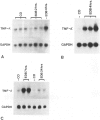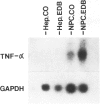Abstract
We have recently demonstrated that a single injection of the mitogen lead nitrate to rats induced a rapid increase of tumor necrosis factor-alpha (TNF-alpha) mRNA in the liver and suggested that this cytokine may be involved in triggering hepatocyte proliferation in this model of direct hyperplasia. In this study, we examined whether a similar induction of liver TNF-alpha mRNA could be observed preceding the onset of hepatocyte proliferation induced by ethylene dibromide, another hepatocyte mitogen. In addition, we used dexamethasone, a well known inhibitor of TNF-alpha production, to determine whether its administration could suppress hepatocyte proliferation induced by lead nitrate and ethylene dibromide. A single intragastric administration of ethylene dibromide (100 mg/kg) to male Wistar rats enhanced liver TNF-alpha mRNA after 4 and 7 hours, which then returned to control levels by 24 hours. TNF-alpha mRNA was detectable only in a nonparenchymal cell fraction of the liver. Pretreatment of rats with a single dose of dexamethasone (2 mg/kg) 60 minutes before lead nitrate (100 mumol/kg) or ethylene dibromide completely abolished the increased levels of liver TNF-alpha mRNA induced by these agents. Inhibition by dexamethasone of TNF-alpha mRNA was associated with an inhibition of liver cell proliferation induced by these mitogens, as measured by [3H]thymidine incorporation into hepatic DNA, mitotic index, and DNA content. These results further support the hypothesis that TNF-alpha may be involved in triggering hepatocyte proliferation induced by primary mitogens.
Full text
PDF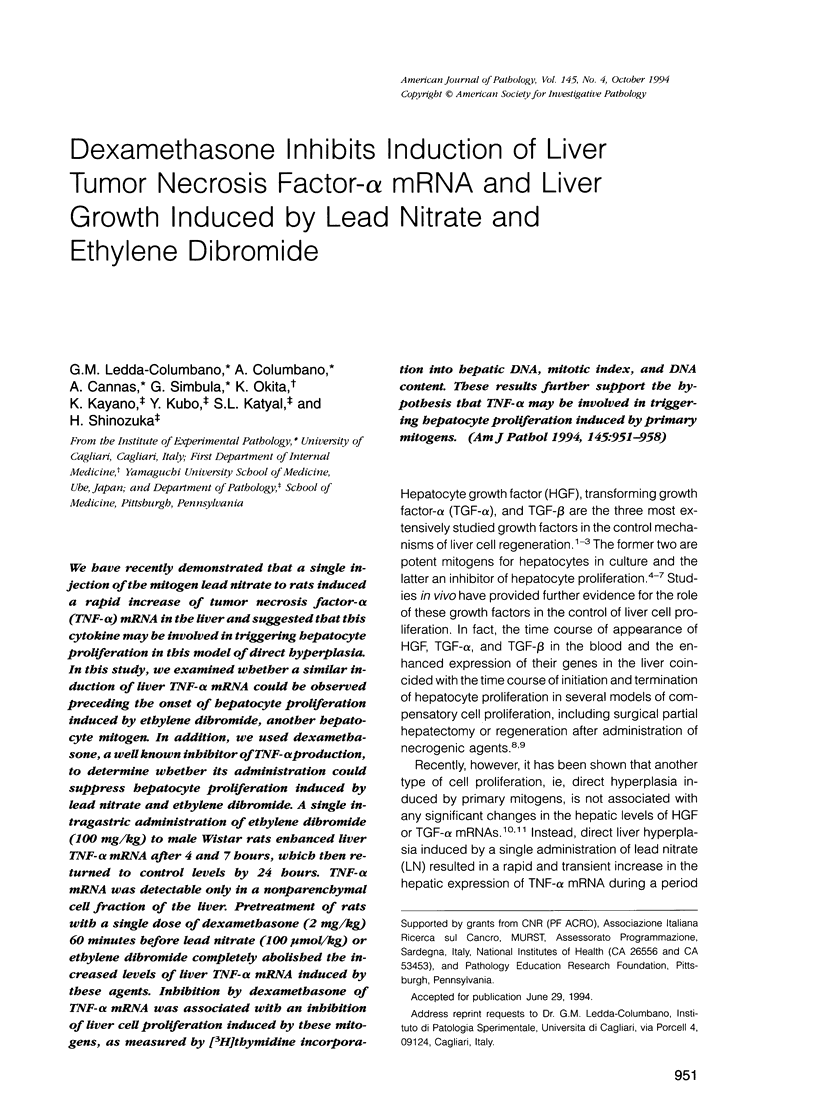
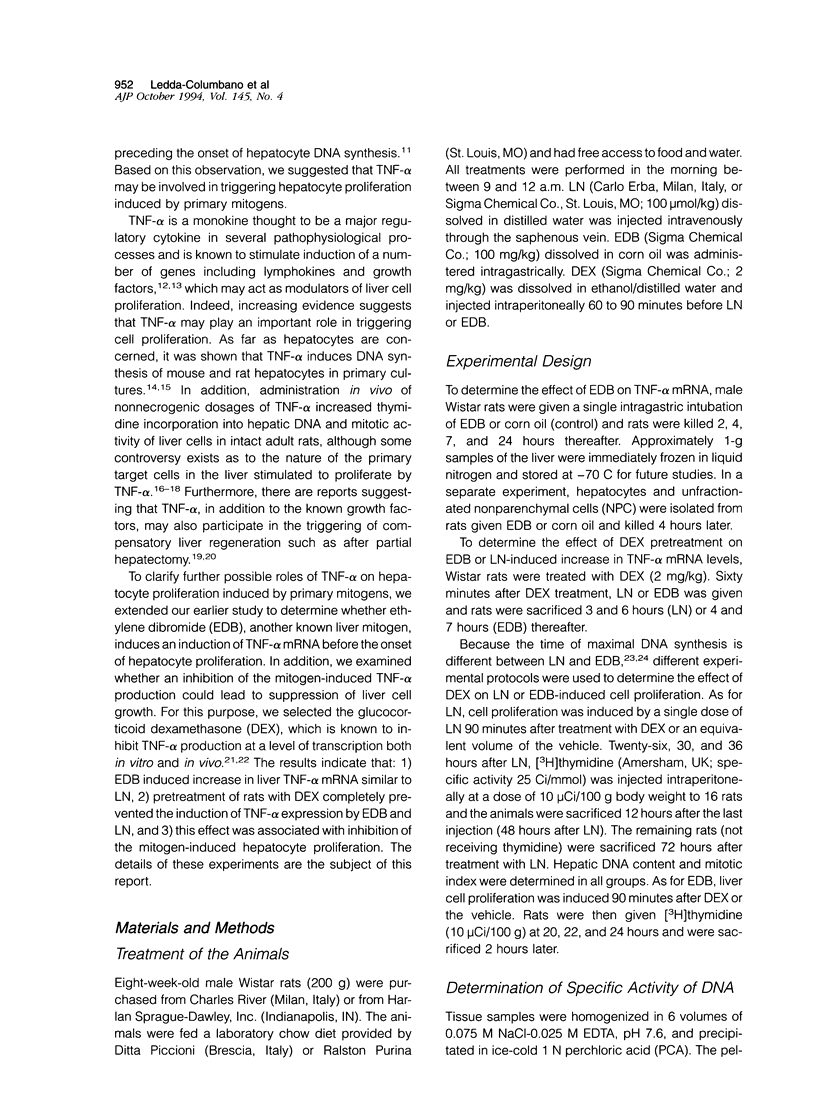
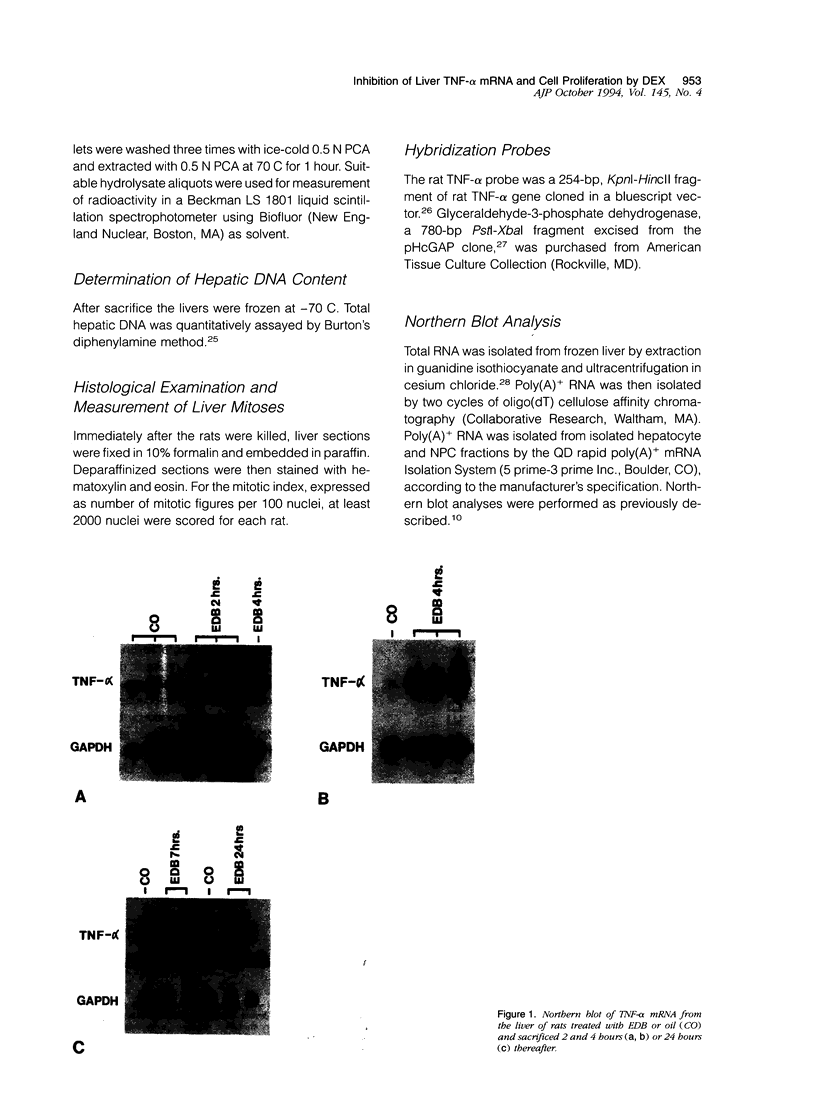
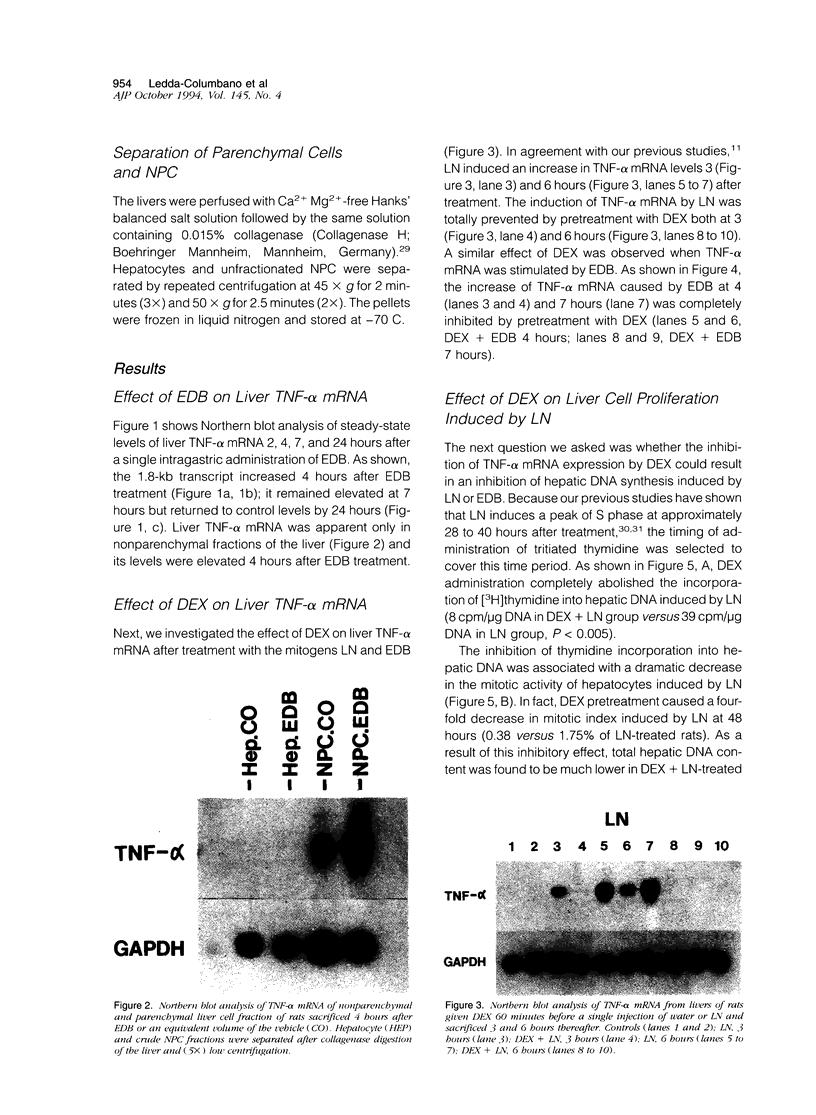
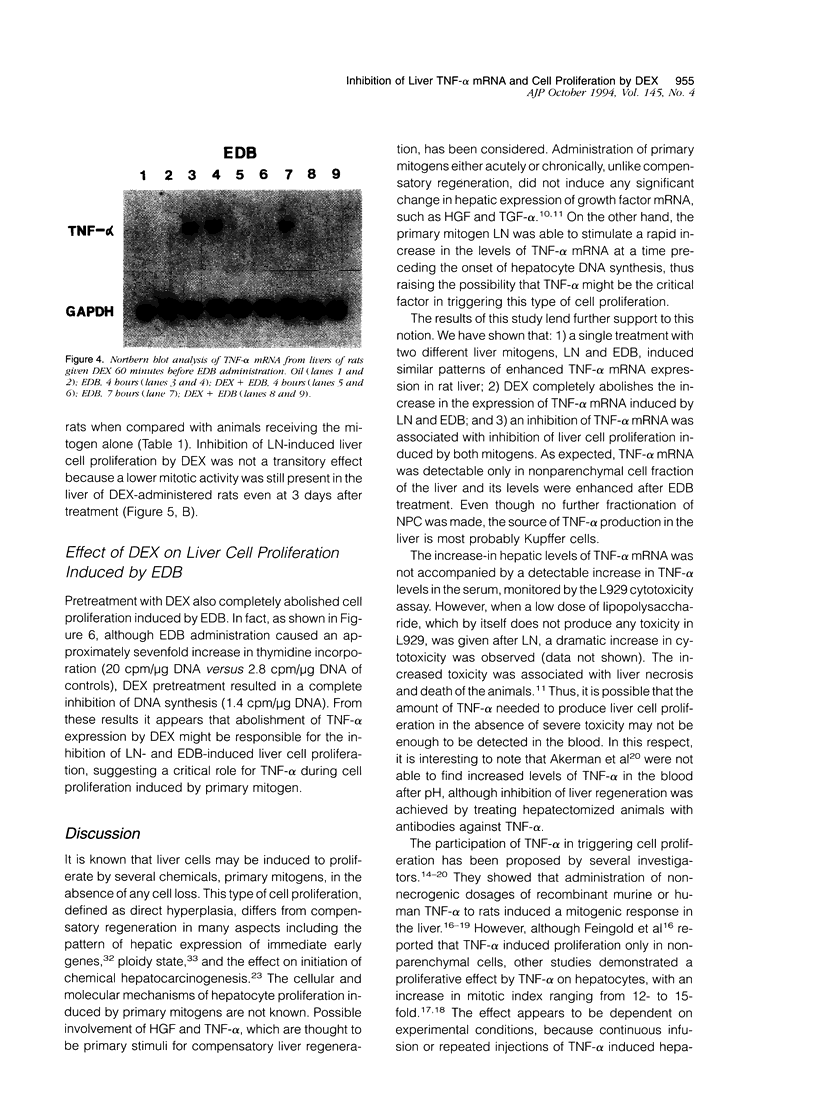
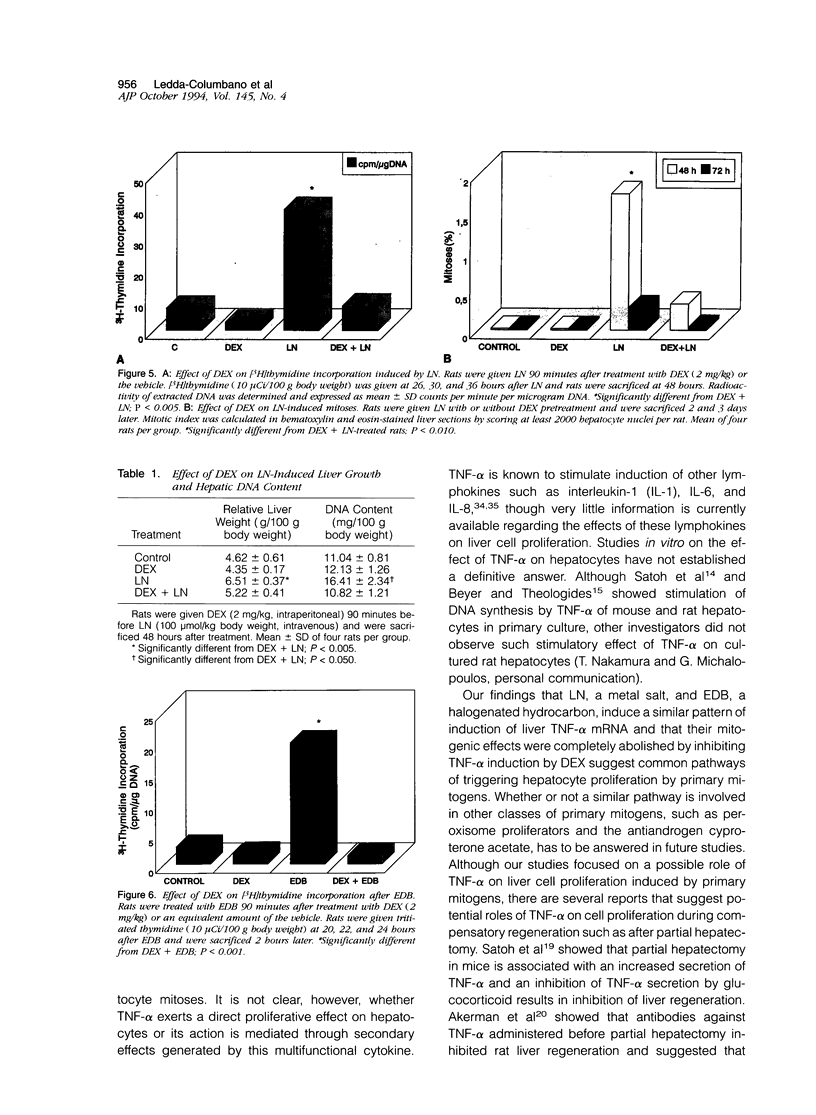
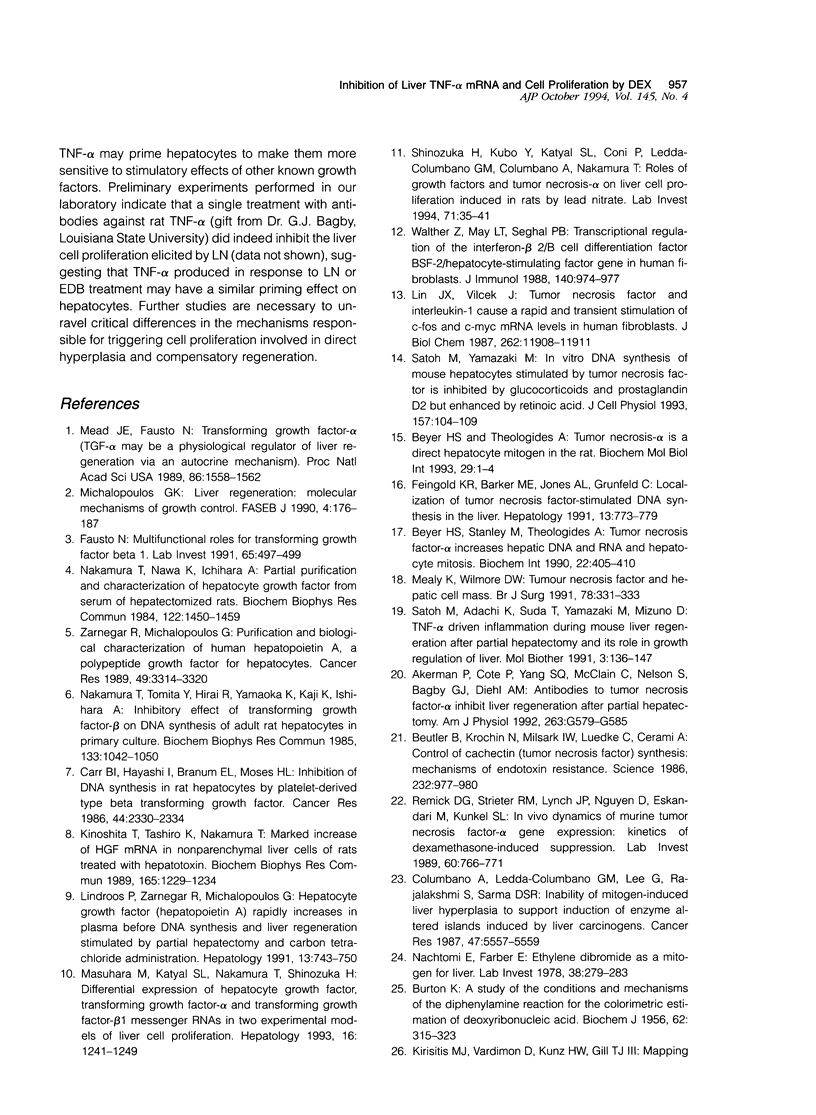
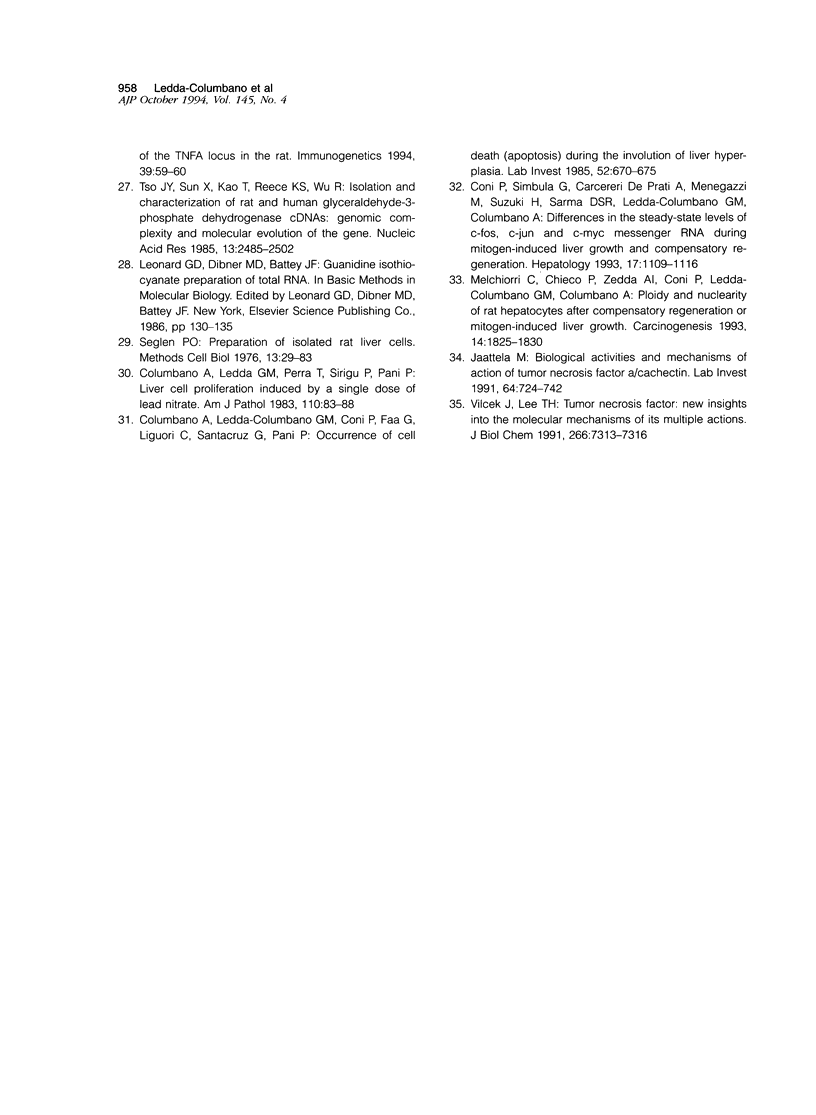
Images in this article
Selected References
These references are in PubMed. This may not be the complete list of references from this article.
- Akerman P., Cote P., Yang S. Q., McClain C., Nelson S., Bagby G. J., Diehl A. M. Antibodies to tumor necrosis factor-alpha inhibit liver regeneration after partial hepatectomy. Am J Physiol. 1992 Oct;263(4 Pt 1):G579–G585. doi: 10.1152/ajpgi.1992.263.4.G579. [DOI] [PubMed] [Google Scholar]
- BURTON K. A study of the conditions and mechanism of the diphenylamine reaction for the colorimetric estimation of deoxyribonucleic acid. Biochem J. 1956 Feb;62(2):315–323. doi: 10.1042/bj0620315. [DOI] [PMC free article] [PubMed] [Google Scholar]
- Beutler B., Krochin N., Milsark I. W., Luedke C., Cerami A. Control of cachectin (tumor necrosis factor) synthesis: mechanisms of endotoxin resistance. Science. 1986 May 23;232(4753):977–980. doi: 10.1126/science.3754653. [DOI] [PubMed] [Google Scholar]
- Beyer H. S., Stanley M. Tumor necrosis factor-alpha increases hepatic DNA and RNA and hepatocyte mitosis. Biochem Int. 1990 Nov;22(3):405–410. [PubMed] [Google Scholar]
- Beyer H. S., Theologides A. Tumor necrosis factor-alpha is a direct hepatocyte mitogen in the rat. Biochem Mol Biol Int. 1993 Jan;29(1):1–4. [PubMed] [Google Scholar]
- Carr B. I., Hayashi I., Branum E. L., Moses H. L. Inhibition of DNA synthesis in rat hepatocytes by platelet-derived type beta transforming growth factor. Cancer Res. 1986 May;46(5):2330–2334. [PubMed] [Google Scholar]
- Columbano A., Ledda-Columbano G. M., Coni P. P., Faa G., Liguori C., Santa Cruz G., Pani P. Occurrence of cell death (apoptosis) during the involution of liver hyperplasia. Lab Invest. 1985 Jun;52(6):670–675. [PubMed] [Google Scholar]
- Columbano A., Ledda-Columbano G. M., Lee G., Rajalakshmi S., Sarma D. S. Inability of mitogen-induced liver hyperplasia to support the induction of enzyme-altered islands induced by liver carcinogens. Cancer Res. 1987 Nov 1;47(21):5557–5559. [PubMed] [Google Scholar]
- Columbano A., Ledda G. M., Sirigu P., Perra T., Pani P. Liver cell proliferation induced by a single dose of lead nitrate. Am J Pathol. 1983 Jan;110(1):83–88. [PMC free article] [PubMed] [Google Scholar]
- Coni P., Simbula G., de Prati A. C., Menegazzi M., Suzuki H., Sarma D. S., Ledda-Columbano G. M., Columbano A. Differences in the steady-state levels of c-fos, c-jun and c-myc messenger RNA during mitogen-induced liver growth and compensatory regeneration. Hepatology. 1993 Jun;17(6):1109–1116. [PubMed] [Google Scholar]
- Fausto N. Multifunctional roles for transforming growth factor-beta 1. Lab Invest. 1991 Nov;65(5):497–499. [PubMed] [Google Scholar]
- Feingold K. R., Barker M. E., Jones A. L., Grunfeld C. Localization of tumor necrosis factor-stimulated DNA synthesis in the liver. Hepatology. 1991 Apr;13(4):773–779. [PubMed] [Google Scholar]
- Jättelä M. Biologic activities and mechanisms of action of tumor necrosis factor-alpha/cachectin. Lab Invest. 1991 Jun;64(6):724–742. [PubMed] [Google Scholar]
- Kinoshita T., Tashiro K., Nakamura T. Marked increase of HGF mRNA in non-parenchymal liver cells of rats treated with hepatotoxins. Biochem Biophys Res Commun. 1989 Dec 29;165(3):1229–1234. doi: 10.1016/0006-291x(89)92733-2. [DOI] [PubMed] [Google Scholar]
- Lin J. X., Vilcek J. Tumor necrosis factor and interleukin-1 cause a rapid and transient stimulation of c-fos and c-myc mRNA levels in human fibroblasts. J Biol Chem. 1987 Sep 5;262(25):11908–11911. [PubMed] [Google Scholar]
- Lindroos P. M., Zarnegar R., Michalopoulos G. K. Hepatocyte growth factor (hepatopoietin A) rapidly increases in plasma before DNA synthesis and liver regeneration stimulated by partial hepatectomy and carbon tetrachloride administration. Hepatology. 1991 Apr;13(4):743–750. [PubMed] [Google Scholar]
- Masuhara M., Katyal S. L., Nakamura T., Shinozuka H. Differential expression of hepatocyte growth factor, transforming growth factor-alpha and transforming growth factor-beta 1 messenger RNAs in two experimental models of liver cell proliferation. Hepatology. 1992 Nov;16(5):1241–1249. [PubMed] [Google Scholar]
- Mead J. E., Fausto N. Transforming growth factor alpha may be a physiological regulator of liver regeneration by means of an autocrine mechanism. Proc Natl Acad Sci U S A. 1989 Mar;86(5):1558–1562. doi: 10.1073/pnas.86.5.1558. [DOI] [PMC free article] [PubMed] [Google Scholar]
- Mealy K., Wilmore D. W. Tumour necrosis factor increases hepatic cell mass. Br J Surg. 1991 Mar;78(3):331–333. doi: 10.1002/bjs.1800780320. [DOI] [PubMed] [Google Scholar]
- Melchiorri C., Chieco P., Zedda A. I., Coni P., Ledda-Columbano G. M., Columbano A. Ploidy and nuclearity of rat hepatocytes after compensatory regeneration or mitogen-induced liver growth. Carcinogenesis. 1993 Sep;14(9):1825–1830. doi: 10.1093/carcin/14.9.1825. [DOI] [PubMed] [Google Scholar]
- Michalopoulos G. K. Liver regeneration: molecular mechanisms of growth control. FASEB J. 1990 Feb 1;4(2):176–187. [PubMed] [Google Scholar]
- Miller R. G., Pinto da Silva P. Particle rosettes in the periaxonal Schwann cell membrane and particle clusters in the axolemma of rat sciatic nerve. Brain Res. 1977 Jul 8;130(1):135–141. doi: 10.1016/0006-8993(77)90848-4. [DOI] [PubMed] [Google Scholar]
- Nachtomi E., Farber E. Ethylene dibromide as a mitogen for liver. Lab Invest. 1978 Mar;38(3):279–283. doi: 10.3109/00365517809108424. [DOI] [PubMed] [Google Scholar]
- Nakamura T., Nawa K., Ichihara A. Partial purification and characterization of hepatocyte growth factor from serum of hepatectomized rats. Biochem Biophys Res Commun. 1984 Aug 16;122(3):1450–1459. doi: 10.1016/0006-291x(84)91253-1. [DOI] [PubMed] [Google Scholar]
- Nakamura T., Tomita Y., Hirai R., Yamaoka K., Kaji K., Ichihara A. Inhibitory effect of transforming growth factor-beta on DNA synthesis of adult rat hepatocytes in primary culture. Biochem Biophys Res Commun. 1985 Dec 31;133(3):1042–1050. doi: 10.1016/0006-291x(85)91241-0. [DOI] [PubMed] [Google Scholar]
- Remick D. G., Strieter R. M., Lynch J. P., 3rd, Nguyen D., Eskandari M., Kunkel S. L. In vivo dynamics of murine tumor necrosis factor-alpha gene expression. Kinetics of dexamethasone-induced suppression. Lab Invest. 1989 Jun;60(6):766–771. [PubMed] [Google Scholar]
- Satoh M., Adachi K., Suda T., Yamazaki M., Mizuno D. TNF-driven inflammation during mouse liver regeneration after partial hepatectomy and its role in growth regulation of liver. Mol Biother. 1991 Sep;3(3):136–147. [PubMed] [Google Scholar]
- Satoh M., Yamazaki M. In vitro DNA synthesis of mouse hepatocytes stimulated by tumor necrosis factor is inhibited by glucocorticoids and prostaglandin D2 but enhanced by retinoic acid. J Cell Physiol. 1993 Oct;157(1):104–109. doi: 10.1002/jcp.1041570114. [DOI] [PubMed] [Google Scholar]
- Seglen P. O. Preparation of isolated rat liver cells. Methods Cell Biol. 1976;13:29–83. doi: 10.1016/s0091-679x(08)61797-5. [DOI] [PubMed] [Google Scholar]
- Shinozuka H., Kubo Y., Katyal S. L., Coni P., Ledda-Columbano G. M., Columbano A., Nakamura T. Roles of growth factors and of tumor necrosis factor-alpha on liver cell proliferation induced in rats by lead nitrate. Lab Invest. 1994 Jul;71(1):35–41. [PubMed] [Google Scholar]
- Tso J. Y., Sun X. H., Kao T. H., Reece K. S., Wu R. Isolation and characterization of rat and human glyceraldehyde-3-phosphate dehydrogenase cDNAs: genomic complexity and molecular evolution of the gene. Nucleic Acids Res. 1985 Apr 11;13(7):2485–2502. doi: 10.1093/nar/13.7.2485. [DOI] [PMC free article] [PubMed] [Google Scholar]
- Vilcek J., Lee T. H. Tumor necrosis factor. New insights into the molecular mechanisms of its multiple actions. J Biol Chem. 1991 Apr 25;266(12):7313–7316. [PubMed] [Google Scholar]
- Walther Z., May L. T., Sehgal P. B. Transcriptional regulation of the interferon-beta 2/B cell differentiation factor BSF-2/hepatocyte-stimulating factor gene in human fibroblasts by other cytokines. J Immunol. 1988 Feb 1;140(3):974–977. [PubMed] [Google Scholar]
- Zarnegar R., Michalopoulos G. Purification and biological characterization of human hepatopoietin A, a polypeptide growth factor for hepatocytes. Cancer Res. 1989 Jun 15;49(12):3314–3320. [PubMed] [Google Scholar]



